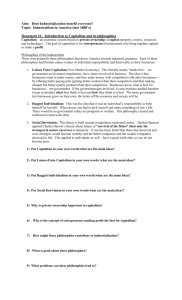13_ U_S_ Big Business
advertisement
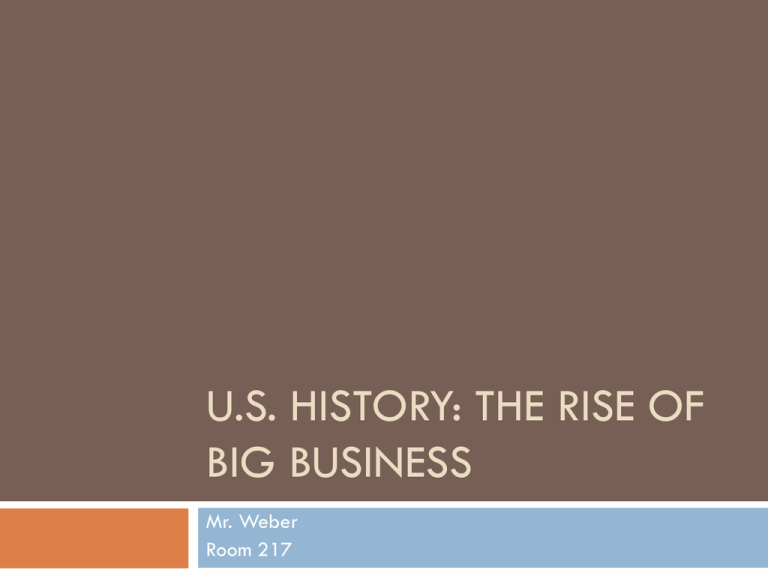
U.S. HISTORY: THE RISE OF BIG BUSINESS Mr. Weber Room 217 Activator: Write a summary of the notes from Monday Describe the changing landscape of late nineteenth century America by examining the movements of people, rise of industry, growth of transportation, and development of cities. (11.2.2). Make sure to include: Countries where immigrants came from. Growth of cities, slums, ethnic neighborhoods. Urban political machines and bosses. Causes of industrialization (transportation, technology, factories, skilled to unskilled labor) Market economy Agenda Activator, agenda, and objective (10 minutes) Rise of Big Business Notes (15-20 minutes) Ch. 16 Jigsaw Reading (30-45 minutes) Made in LA video clip (30-45 minutes) Exit slip and homework (5 minutes) Objective All students discuss the corporate mergers that produced trusts and cartels and the economic and political policies of industrial leaders (like Andrew Carnegie and John D. Rockefeller). 11.2.5. The Market Economy Major Shifts: From family farms to open competition in “the market.” From hand tools to complex machines From skilled to unskilled labor Key Terms: Specialization – meaning you concentrate on one thing Production – to make or produce goods and services Consumption – to consume like eat but more generally to buy and to use things that are produced. Competition – firms will compete for business keeping prices low for everyone. Supply and Demand: the market is regulated by an invisible hand – the laws of supply (how much is made available) and demand (how many people need it or want it). Rise of Big Business Key Term: LAISSEZ FAIRE – the ideology of the industrial age. Individual as moral and economic ideal. Individuals should compete freely in the marketplace. No room for the government in the market. Private enterprise can do things better than government. Social Darwinism British economist Herbert Spencer Advocate of Laissez Faire Adapted Darwin’s ideas from “Origin of the Species” to human behavior. Notion of survival of the fittest William Graham Sumner Social Darwinism in America. Wrote “Folkways” 1906 Individuals must have complete freedom to struggle, succeed or fail Therefore government intervention to reward society or economy is pointless New Types of Business John D. Rockefeller wanted to buy out the competition but government prevented companies from owning the stock of other companies (reduce competition, etc.) So he formed a board of trustees which he controlled to manage companies combined into a “TRUST.” Because they did not merge they violated no laws. Still, Carnegie was able to create a monopoly which controlled the majority of the nation’s oil refining companies. Standard Oil Co. New Types of Businesses and Elites TRUSTS: Horizontal integration: method of industrial control by which you buy up competitors factories in order to form one large one. – John D. Rockefeller: Standard Oil Co. Vertical consolidation: a method of industrial control in which a company buys up all the different aspects involved in that business. Andrew Carnegie: Carnegie Steel bought the coke fields, iron ore deposits, steel mills, ships, and railroads. CARTELS: Loose association of business that make the same produce. Agree to limit the supply to keep prices high. Iron and Steel Production Abundant Natural Resources New Types of Business Elites Corporate Mergers Reorganization of Work Fredrick Taylor Scientific Management The assembly Line Percent of Billionaires (1900) Percent Billionaires (1918) Andrew Carnegie: “On Wealth” - The Anglo Saxon race is superior. - “Gospel of Wealth” (1901) - Inequality is inevitable and good. - Wealthy should act as trustees for poor people. John D. Rockefeller: Robber Barron or Captain of Industry? Robber Barron: A pejorative (not nice) term for a businessman who dominated his industry by using unfair business practices and made a huge personal fortune. Captain of Industry: A term used to describe a business man who got to the top because he was the best at what he did. Also refers to his leadership in giving back to the community through philanthropy (giving money for libraries, schools, etc.). Robber Barron or Captain of Industry? 1. Captain. 2. Robber. 3. Captain. 4. Robber. 5. Captain. 6. Captain. 7. Captain. 8. Robber. 9. Captain. 10. Robber. Ch. 16: America’s Gilded Age Jigsaw Reading: In groups of 2-3, read/teach 1. America’s Gilded Age introduction pp.590-91 2. The Second Industrial Revolution, pp.591-92 3. The Industrial Economy, pp.592-93 4. Railroads and the National Market, pp.593-95 5. The Spirit of Innovation, pp.595-96 6.Competition and Consolidation, pp.596-97 7. The Rise of Andrew Carnegie, pp.597-98 8. The Triumph of John D. Rockefeller, pp.598-99 9. Worker’s Freedom in an Industrial Age, pp.599-600. 10. Increasing Wealth and Poverty, pp.600-601. The Response of Reformers In groups of 4 take notes on one of the below options and then make a bumper sticker with an image and a slogan. Be prepared to present your work. 1. Upton Sinclair’s The Jungle (Handout, pp.1-5) 2. Middle Class reformers: Charity, Social Gospel, Settlement Movement, Temperance and Prohibition (Textbook pp.541-545) Exit Ticket What do you anticipate? If you were not a billionaire but a worker at this time what do you imagine life was like? How would you respond to working conditions that included low wages, a 12-14 hour day, poor safety and sanitation, and little job security? What do you think workers at this time did?
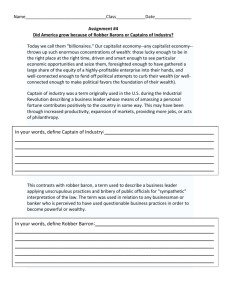
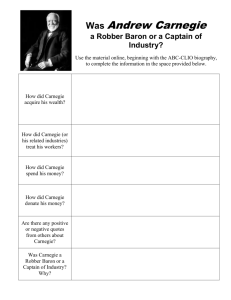
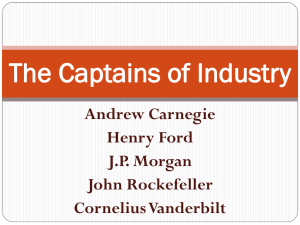

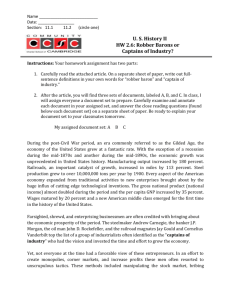
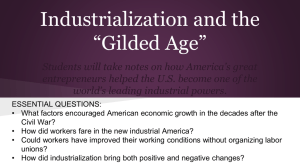
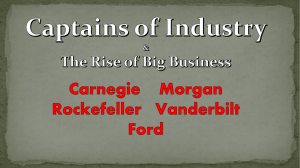
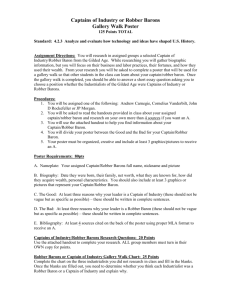
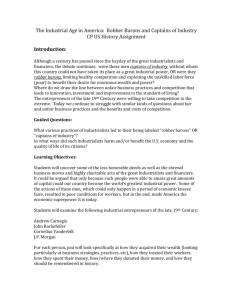
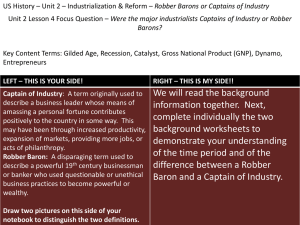
![men_who_built_america[1]](http://s2.studylib.net/store/data/005219845_1-7979604da89ac700f7913bb56611cc41-300x300.png)
